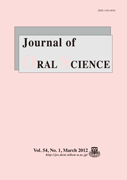Volume 54, Issue 3
September
Displaying 1-11 of 11 articles from this issue
- |<
- <
- 1
- >
- >|
Review
-
2012Volume 54Issue 3 Pages 205-211
Published: 2012
Released on J-STAGE: October 09, 2012
Download PDF (939K)
Original
-
2012Volume 54Issue 3 Pages 213-217
Published: 2012
Released on J-STAGE: October 09, 2012
Download PDF (759K) -
2012Volume 54Issue 3 Pages 219-225
Published: 2012
Released on J-STAGE: October 09, 2012
Download PDF (814K) -
2012Volume 54Issue 3 Pages 227-232
Published: 2012
Released on J-STAGE: October 09, 2012
Download PDF (850K) -
2012Volume 54Issue 3 Pages 233-239
Published: 2012
Released on J-STAGE: October 09, 2012
Download PDF (934K) -
2012Volume 54Issue 3 Pages 241-250
Published: 2012
Released on J-STAGE: October 09, 2012
Download PDF (990K) -
2012Volume 54Issue 3 Pages 251-259
Published: 2012
Released on J-STAGE: October 09, 2012
Download PDF (755K) -
2012Volume 54Issue 3 Pages 261-266
Published: 2012
Released on J-STAGE: October 09, 2012
Download PDF (716K) -
2012Volume 54Issue 3 Pages 267-272
Published: 2012
Released on J-STAGE: October 09, 2012
Download PDF (880K) -
2012Volume 54Issue 3 Pages 273-278
Published: 2012
Released on J-STAGE: October 09, 2012
Download PDF (826K) -
2012Volume 54Issue 3 Pages 279-283
Published: 2012
Released on J-STAGE: October 09, 2012
Download PDF (697K)
- |<
- <
- 1
- >
- >|
